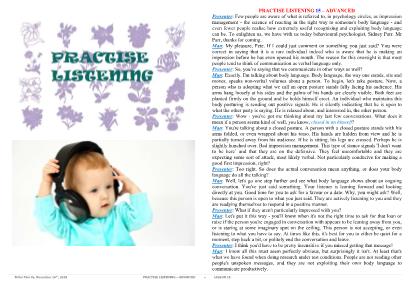Bài thực hành nghe Tiếng Anh nâng cao - Bài 15 - Thẩm Tâm Vy - Năm 2018 (Có âm thanh)
Bạn đang xem tài liệu "Bài thực hành nghe Tiếng Anh nâng cao - Bài 15 - Thẩm Tâm Vy - Năm 2018 (Có âm thanh)", để tải tài liệu gốc về máy bạn click vào nút DOWNLOAD ở trên

Thẩm Tâm Vy, November 16th, 2018 PRACTISE LISTENING – ADVANCED – LESSON 15 PRACTISE LISTENING 15 – ADVANCED Presenter: Few people are aware of what is referred to, in psychology circles, as impression management - the science of reacting in the right way to someone's body language - and even fewer people realise how extremely useful recognising and exploiting body language can be. To enlighten us, we have with us today behavioural psychologist, Sidney Parr. Mr Parr, thanks for coming. Man: My pleasure, Pete. If I could just comment on something you just said? You were correct in saying that it is a rare individual indeed who is aware that he is making an impression before he has even opened his mouth. The reason for this oversight is that most people tend to think of communication as verbal language only. Presenter: So, you’re saying that we communicate in other ways as well? Man: Exactly. I'm talking about body language. Body language, the way one stands, sits and moves, speaks non-verbal volumes about a person. To begin, let's take posture. Now, a person who is adopting what we call an open posture stands fully facing his audience. His arms hang loosely at his sides and the palms of his hands are clearly visible. Both feet are planted firmly on the ground and he holds himself erect. An individual who maintains this body posturing is sending out positive signals. He is silently indicating that he is open to what the other party is saying. He is relaxed about, and interested in, the other person. Presenter: Wow - you've got me thinking about my last few conversations. What does it mean if a person seems kind of well, you know, closed in on himself? Man: You're talking about a closed posture. A person with a closed posture stands with his arms folded, or even wrapped about his torso. His hands are hidden from view and he is partially turned away from his audience. If he is sitting, his legs are crossed. Perhaps he is slightly hunched over. Bad impression management. This type of stance signals 'I don't want to be here’ and that they are on the defensive. They feel uncomfortable and they are expecting some sort of attack, most likely verbal. Not particularly conducive for making a good first impression, right? Presenter: Too right. So does the actual conversation mean anything, or does your body language do all the talking? Man: Well, let's go one step further and see what body language shows about an ongoing conversation. You've just said something. Your listener is leaning forward and looking directly at you. Good time for you to ask for a favour or a date. Why, you might ask? Well, because this person is open to what you just said. They are actively listening to you and they are readying themselves to respond in a positive manner. Presenter: What if they aren't particularly impressed with you? Man: Let's put it this way - you'll know when it's not the right time to ask for that loan or raise if the person you're engaged in conversation with appears to be leaning away from you, or is staring at some imaginary spot on the ceiling. This person is not accepting, or even listening to what you have to say. At times like this, it's best for you to either be quiet for a moment, step back a bit, or politely end the conversation and leave. Presenter: I think you'd have to be pretty insensitive if you missed getting that message! Man: I know all this must seem perfectly obvious, but surprisingly it isn't. At least that's what we have found when doing research under test conditions. People are not reading other people's unspoken messages, and they are not exploiting their own body language to communicate productively.
Tài liệu đính kèm:
 bai_thuc_hanh_nghe_tieng_anh_nang_cao_bai_15_tham_tam_vy_nam.pdf
bai_thuc_hanh_nghe_tieng_anh_nang_cao_bai_15_tham_tam_vy_nam.pdf 01. LISTENING 15 (Slow).mp3
01. LISTENING 15 (Slow).mp3 02. LISTENING 15 (Normal).mp3
02. LISTENING 15 (Normal).mp3





